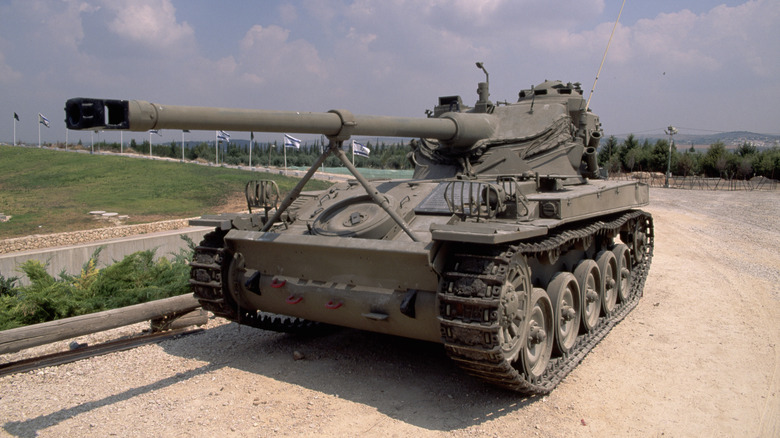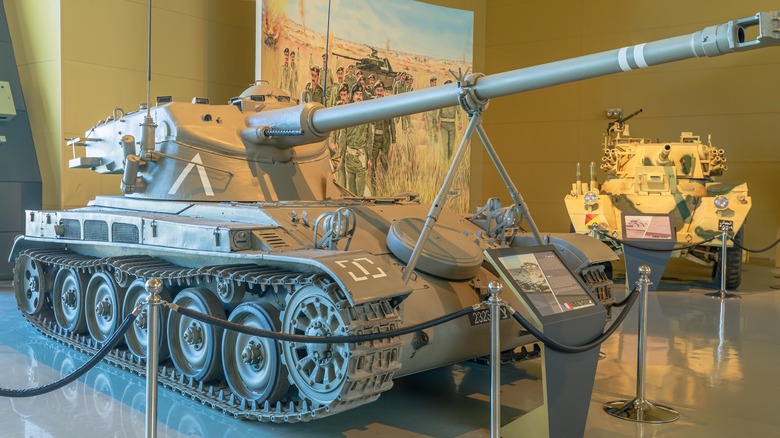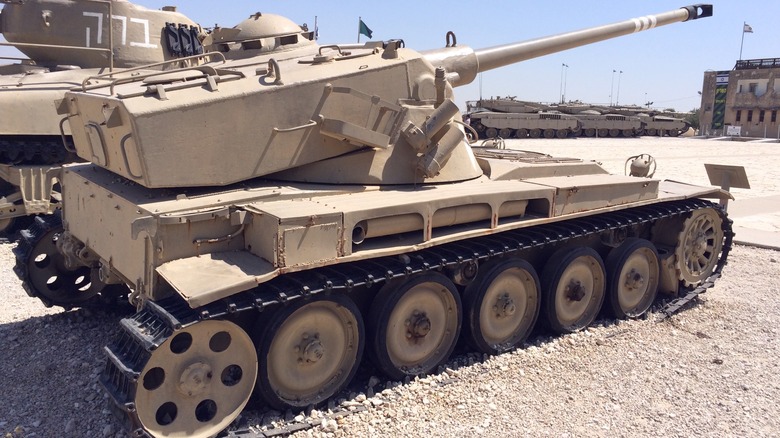How Unconventional Usage Led To Israel's Retirement Of The AMX-13 Tank
Israel has never been too far from military conflict, and immediately after its formation in 1948, it found itself surrounded by enemies. Those enemies didn't waste much time in attacking either, and as a result, Israel has built up an impressive military force. By 1967, Israel found itself facing off against the combined might of Egypt, Jordan, Iraq, Lebanon, and Syria in the third Arab-Israeli war that's best known as the Six-Day War.
The Six-Day War took place from June 5-10, 1967, and it was intense. The outcome of the conflict saw Israel seize new territory in Syria's Golan Heights, the Jordanian-annexed West Bank and East Jerusalem, and Egypt's Sinai Peninsula and the Gaza Strip. Israel was prepared for the conflict, and when it kicked off, the small nation fielded hundreds of tanks, including 400 French-made AMX-13 light tanks, though it's fair to say Israel used them unconventionally.
The Israeli Defense Force's (IDF) inexperience with main battle tanks in combat meant they didn't employ the AMX-13 appropriately. Instead of using the light tanks for reconnaissance missions or other support activities, the IDF placed the AMX-13s it possessed into frontline duties. This resulted in an increase in casualties, making the AMX-13 a less desirable option for Israel, and soon after the conflict, the IDF retired the AMX-13 from its inventory.
What is an AMX-13?
France began building and fielding the AMX-13 in 1952 and sold it to various partners around the world, including Israel. The light tank weighed only 14.5 tons, which helped give it an operational range of 250 miles and a maximum speed of 37 mph. The tank's crew consisted of three personnel: a commander, a gunner, and a driver. As a light tank, the AMX-13's design made it ideal for reconnaissance work, and numerous adaptations resulted in dozens of useful variants.
Depending on their configuration, an AMX-13 could function as an armored personnel carrier, anti-aircraft platform, self-propelled gun, and much more. The AMx-13's main gun was a 75mm SA 50, which was loaded via an automatic six-round automatic loader. Other variants used larger-bore main guns, and a variety of machine guns could be attached to the tank as well. The tank also featured smoke grenade launchers for protection.
For armor, the AMX-13 was minimally covered with steel armor. This kept the tank relatively light but only protected it from small-arms fire and shrapnel. Very little could be done to stop anti-tank munitions or other heavier ordnance, limiting the AMX-13's protection. This necessitated a strategy that employed the tank for fast maneuverability and not frontline work, which is how the IDF decided to use them during the Six-Day War.
How the IDF used AMX-13's unconventionally during the Six Day War
When the Six-Day War kicked off, the Arab states attacking Israel brought 1,700 tanks to the fight. With most of those coming from Egypt, Israel focused much of its armor on the Sinai Desert. Israel fielded three tank battalions of AMX-13s, and it sent many to Abu-Ageila in the Sinai Desert, while two of the three battalions fought in the Gaza Strip and the Golan Heights. The Battle of Abu-Ageila saw Israel's decisive victory against Egypt, taking the Sinai Peninsula from its neighbor.
Most of Egypt's tanks were older WWII models, while Israel fielded the AMX-13, British Centurions, and American Sherman tanks. Unfortunately, the IDF placed its AMX-13s at the front lines, using it unconventionally for a light tank and costing the IDF considerably. With proper planning and more experience with main battle tanks, the IDF should have used its AMX-13s for reconnaissance. Instead, they fought with it on the front lines, with heavy losses sustained at Rafah Junction and the Jiradi Pass.
Ultimately, tankers operating AMX-13s during the Six-Day War experienced far heavier casualties than they should have had if they had been employed correctly. After the war, the IDF reconsidered its use of the lightly armored, small-gunned French tank and retired it from the inventory. All remaining stocks of AMX-13s were sold to Singapore, with the first delivery of tanks arriving at the island nation in June 1969. After the AMX-13, Israel developed its own main battle tank, the Merkava, which it first used in combat in 1982's Lebanon War.
[Featured image by Katangais via Wikimedia Commons | Cropped and scaled | CC BY 2.5]


